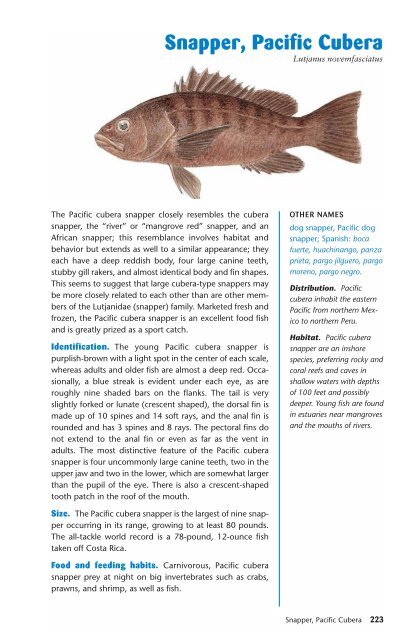Ken Schultz's Field Guide to Saltwater Fish - Macaw Pets store
Ken Schultz's Field Guide to Saltwater Fish - Macaw Pets store
Ken Schultz's Field Guide to Saltwater Fish - Macaw Pets store
Create successful ePaper yourself
Turn your PDF publications into a flip-book with our unique Google optimized e-Paper software.
The Pacific cubera snapper closely resembles the cubera<br />
snapper, the “river” or “mangrove red” snapper, and an<br />
African snapper; this resemblance involves habitat and<br />
behavior but extends as well <strong>to</strong> a similar appearance; they<br />
each have a deep reddish body, four large canine teeth,<br />
stubby gill rakers, and almost identical body and fin shapes.<br />
This seems <strong>to</strong> suggest that large cubera-type snappers may<br />
be more closely related <strong>to</strong> each other than are other members<br />
of the Lutjanidae (snapper) family. Marketed fresh and<br />
frozen, the Pacific cubera snapper is an excellent food fish<br />
and is greatly prized as a sport catch.<br />
Identification. The young Pacific cubera snapper is<br />
purplish-brown with a light spot in the center of each scale,<br />
whereas adults and older fish are almost a deep red. Occasionally,<br />
a blue streak is evident under each eye, as are<br />
roughly nine shaded bars on the flanks. The tail is very<br />
slightly forked or lunate (crescent shaped), the dorsal fin is<br />
made up of 10 spines and 14 soft rays, and the anal fin is<br />
rounded and has 3 spines and 8 rays. The pec<strong>to</strong>ral fins do<br />
not extend <strong>to</strong> the anal fin or even as far as the vent in<br />
adults. The most distinctive feature of the Pacific cubera<br />
snapper is four uncommonly large canine teeth, two in the<br />
upper jaw and two in the lower, which are somewhat larger<br />
than the pupil of the eye. There is also a crescent-shaped<br />
<strong>to</strong>oth patch in the roof of the mouth.<br />
Size. The Pacific cubera snapper is the largest of nine snapper<br />
occurring in its range, growing <strong>to</strong> at least 80 pounds.<br />
The all-tackle world record is a 78-pound, 12-ounce fish<br />
taken off Costa Rica.<br />
Food and feeding habits. Carnivorous, Pacific cubera<br />
snapper prey at night on big invertebrates such as crabs,<br />
prawns, and shrimp, as well as fish.<br />
Snapper, Pacific Cubera<br />
Lutjanus novemfasciatus<br />
OTHER NAMES<br />
dog snapper, Pacific dog<br />
snapper; Spanish: boca<br />
fuerte, huachinango, panza<br />
prieta, pargo jilguero, pargo<br />
moreno, pargo negro.<br />
Distribution. Pacific<br />
cubera inhabit the eastern<br />
Pacific from northern Mexico<br />
<strong>to</strong> northern Peru.<br />
Habitat. Pacific cubera<br />
snapper are an inshore<br />
species, preferring rocky and<br />
coral reefs and caves in<br />
shallow waters with depths<br />
of 100 feet and possibly<br />
deeper. Young fish are found<br />
in estuaries near mangroves<br />
and the mouths of rivers.<br />
Snapper, Pacific Cubera 223


